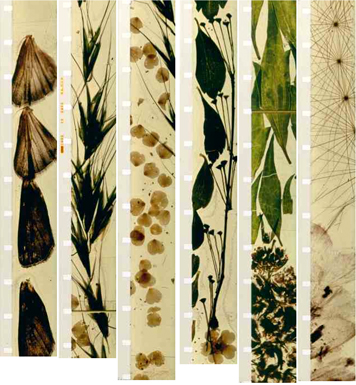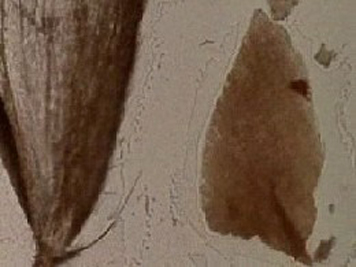
Stan Brakhage: Filmstrips from Mothlight (1963.)
Photographs by Fred Camper.
In an interview some years ago, the American director Mike Nichols was asked to explain how he had come to be so accomplished as a visual storyteller. Directing, he observed, was a lot like sex: you never actually got to watch anyone else doing it, so you were never quite sure whether you were getting it right.
While contemporary design practice is often characterized as a collective endeavor, the actual core design idea — that lightbulb aha moment — still originates in one person's brain. True, it may require more people, more technology, more hands to bring it to life, but conversely, the model of the artist in the studio — alone and focused, generating form, keenly observing — seems oddly underappreciated, probably because it is, by its very nature, such a mystery.
It is also, for that matter, my secret obsession.

Stan Brakhage: Still from Mothlight (1963.)
I read artist diaries and autobiographies as fast as I can get my hands on them. I read the obituaries online (in newspapers on several continents) first thing every morning, looking for stories that feed my habit. Over the past two years, I have also spent a fair amount of time in libraries and private collections looking at sketchbooks, notebooks, scrapbooks and personal papers, doggedly seeking those rare glimmers of certainty — fleeting indications of what a person was actually thinking while they were making something. Increasingly, I've become attuned to small gestures: the fastidiousness of a line, a chance scribble — a seemingly inconsequential, yet ultimately stunning realization about something intangible.
The American filmmaker Stan Brakhage lived a rural life in Colorado, and kept scrapbooks that combine writing, drawing, collage and poetry. There are many things to say about Brakhage, most of them already said by people far more qualified than I am on the subject of avant-garde cinema. But my interest here is less in the product than in the process that preceded it, because what's so striking about Brakhage's scrapbook is the way he sketched with found objects: the scrapbook, in this sense, became a kind of studio annex, a canvas for working out ideas that weren't quite two dimensional but weren't yet time-based either.
And along the way, if you look really closely, you start to get a sense of what he was thinking.
Working in the early 1960s with wide strips of cellophane packing tape, Brakhage captured fleeting things — among them, blades of grass, pieces of flower petals, dust, dirt and the diaphanous, decapitated wings from insects. His process revolved around using the tape to produce a series of facsimile filmstrips: wider than the elegant Super-8 that was his hallmark medium (Mothlight, a mere three minutes in length, was actually shot on 16mm) but long and geometric: they're a suite of attenuated rectangular portraits. The idea of using adhesive tape as a photographic medium (which is effectively what it is, capturing something in time on a single surface) represents the kind of visual simplicity — indeed, the sheer brilliance — of one man's indefatigable effort to visualize an idea. It is, in a word, astonishing.
Was he struck, as I am, by the sheer impossibility of duplicating the same pattern? By the tension between a membrane of sticky tape and a virtual morgue of natural forms? In page after page, you see this entire world opening up beneath a shiny veil of cellophane tape. It's a world of disembodied shapes, where life is rendered silent and inert, only to be revived into these hauntingly beautiful abstract patterns. One becomes suddenly struck by the realization that these compositions preceded his idea for them — they led, and he followed — and that the intensity of this formal exercise would not have been possible in a room full of visual people collaborating on complex problems.
Apples and oranges, you say: how can you compare the collaborative design problem to an artist making an art film? Then again, how can't you?
Sometimes I ask my students, when they're stuck, how much money they have to get through the day. Once we deduct how much they need to eat, I send them to the art supply store down the street and instruct them to buy something they've never seen before, and to use it. The results are always surprising. They take a hiatus from the computer. Stranded, they are obliged to work differently, to think differently — and to see differently. And it is this act of tacit dislocation, this forced hiatus from one's habitual methods that refocuses the brain and refreshes the eye. I don't know how artists do it, all alone every day in the studio, but I do know this: there is a kind of fundamental discipline to seeing and thinking and making truly original work that many of us are losing. And we need to get it back.
The artist in the studio lives a life of intense isolation, yet one which by its very nature produces work that resonates with broader meaning and relevance. By conjecture, this kind of work benefits immeasurably from the imposed solace of the studio, an environment that begets its own fierce concentration. For Stan Brakhage, that concentration resulted in extraordinary explorations of many things, including the life cycle of a moth, caught on adhesive strips of tape, and subsequently captured on film where it regained — however briefly — the magnificent illusion of mobility. For designers, faced by budgets and clients and deadlines, the luxury of so much isolation seems a distant, if not an altogether perverse paradigm. But are these intentions really so mutually exclusive? The more I dig through artists papers and sketchbooks, the more I look — really look — at bodies of work produced in technology-independent, collaboration-free environments, the more I remain fundamentally unconvinced.
